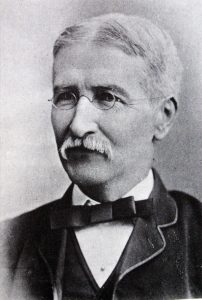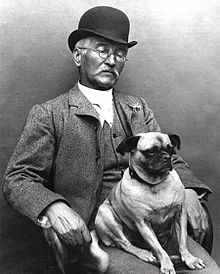(14 November 1830 – 30 November 1909)
The University of North Carolina at Chapel Hill Herbarium (NCU) has cataloged 57 specimens (all fungi) collected by Dr. Peter MacOwan. As our microfungal collection continues to be cataloged, it is possible that more specimens collected by him will be found. All NCU’s fungi can be searched at mycoportal.org
Other herbaria that curate specimens collected by Peter MacOwan include the Bell Museum of Natural History at the University of Minnesota (MIN; lichens, bryophytes); the Farlow Herbarium of Cryptogamic Botany at Harvard University (FH; lichens, fungi); the United States Herbarium, Smithsonian (US; lichens); Uppsala University (UPS; lichens); Cornell Plant Pathology Herbarium (CUP; fungi); Field Museum of Natural History (F; fungi); Illinois Natural History Survey (ILLS; fungi); Kriebel Herbarium, Purdue University (PUL; fungi); New York Botanical Garden (NY; fungi); United States National Fungus Collection (BPI; fungi); University of Illinois Herbarium (ILL; fungi); and the University of Michigan Herbarium (MICH; fungi).

“MacOwan’s early collections [of fungi] were sent to von Thuemen, who distributed many numbers in his Mycotheca universalis. A number were identified by [Georg von] Winter [1848-1887] and were distributed with the Rabenhorst-Winter Fungi Europaei et Extra-europaei. MacOwan prepared several sets of his Fungi austro-africani, of which one was sent to Cooke at Kew, where it was filed in the herbarium, and a second went to Kalchbrenner [Karoly Kalchbrenner, 1807-1886]. A third set of MacOwan’s plants, apparently including fungi, was sent to Theodor M. Fries, for in a letter dated 25th October, 1887, Fries writes from Uppsala: “The fine specimens of Hydnora and Brommeia are now true ornaments to our museum and the centuries that we have last received of your splendid Herbarium austro-africanum must, as well as those we have received before, be considered as the most precious additions that our herbarium have received of late.” A third set was left in Somerset East [South Africa], when MacOwan went to Cape Town, and was later transferred to Grahamstown; this set was acquired by purchase for the Pretoria Herbarium from Dr. S. Schonland [Selmar Schonland; MacOwan’s son-in-law] when he retired from the curatorship of the Albany Museum [in Grahamstown, South Africa]. It is unfortunately not complete, nor is the set in the Herbarium of the South African Museum, Cape Town… Fungi MacOwaniana, of which the majority were collected by Dr. Peter MacOwan in the neighbourhood of Somerset East, the Boschberg and Cape Town. Sets of specimens in the National Herbarium, Pretoria and the South African Museum, Cape Town are incomplete. There is also a set in the Kew Herbarium.”1
According to Wikipedia, Peter MacOwan was born in Hull, Yorkshire and the Humber, England in 1830. After graduating from the University of London in chemistry, he taught at Huddersfield College Laboratory. “A severe lung condition, possibly asthma, caused him to move to South Africa and take up the post of principal at the newly established Shaw College in Grahamstown [in 1861]. His health rapidly improved and leaving chemistry behind he resumed studying botany in which he had become interested while still in England…Finding it a drain on his own time to supply duplicates to overseas collectors, he formed the South African Botanical Exchange Society, which brought together a large number of amateur botanists… Eventually he became head of natural sciences at Gill College, Somerset-East, South Africa and then later director of the Cape Town Botanical Garden and curator of the Cape Government Herbarium.”3, 4
“In South Africa, plant pathology as a science formally began in 1887 with the appointment of Peter MacOwan as the consultant in economic botany to the Cape Government…MacOwan retired in 1905.”4
Peter MacOwan was married to Amelia Day. Their daughter, Flora, married Selmar Schonland, a botanist who had migrated to South Africa from Germany. Peter MacOwan died in Uitenhage, South Africa on 30 November 1909.3
PUBLICATIONS:
MacOwan, Peter and Harry Bolus. 1882. Catalogue of printed books and papers relating to South Africa. Part 1: Botany. IN South African Philosophical Society. Transactions. Volume 2, part 3, pp. 111-187.
SOURCES:
1. http://www.abcjournal.org/index.php/ABC/article/viewFile/1900/1856 accessed on 3 November 2015.
2. http://www.capeorchids.co.za/history.htm accessed on 3 November 2015. [Photo of MacOwen and canine friend]
3. https://en.wikipedia.org/wiki/Peter_MacOwan accessed on 3 November 2015.
4. Rong, Isabella H. and Alice P. Baxter. 2006. The South African National Collection of Fungi: Celebrating a Centenary 1905-2005. Studies in Mycology 55: 1-12. http://www.ncbi.nlm.nih.gov/pmc/articles/PMC2104721/ accessed on 3 November 2015.
